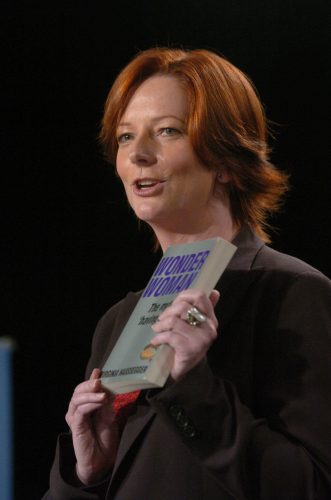If you can’t hear the echo of women’s anger leaking out of Iran right now, or feel the rumble of feet taking to the streets in protest, then you need to listen harder and pay attention.
This is a moment in which we all need to put our ear to the ground, because with an Orwellian reflex worthy of the state of Gilead, the Iranian government has cut off all communications.
The internet is down and the social media platforms Iranians use to communicate with one another and the rest of the world, including WhatsApp and Instagram, are locked out. Silenced.
What we do know first exploded on social media feeds two weeks ago. Astonishing video footage showing furious Iranian women protesting in the streets, building bonfires, burning hijabs and cutting off their hair. All while chanting “Women, life, freedom” and “Death to the dictator”.
This sudden collective action was triggered by the shocking death in custody of 22-year-old Mahsa Amini, detained by the hated morality police for showing too much hair beneath her hijab. Leaked hospital reports suggest she died from blows to the head.
Her family believe police belted her to death. Within hours women took to the streets with placards of Mahsa’s gentle and serene face held high, as a new national symbol of every woman’s oppression.
“We all feel that anyone of us could be Mahsa”, said Dorsa Jabbari, an Aljazeera journalist on the ground in Tehran. As the protests quickly spread to more than 80 cities, across Iran’s 31 provinces, twenty journalists were arrested.
While men were quick to join the protests, from the outset it’s been women standing toe-to-toe with security forces, “taunting them, almost acting as bait” according to The Economist on Wednesday: which also noted that most of the women seemed undeterred, even though they were “getting beat up” by police, who have shown unrestrained aggression.
Although any act of protest in Iran is illegal, small moments of dissent bubble over every few years. But if there is one thing expat Iranians, women’s rights activists and Middle East commentators agree on right now, it is that what started in response to Mahsa Amini’s death is not only different to any previous protests, but the level of anger and women’s actions are unprecedented.
“We have not seen women burning the hijab on the streets like this before”, says Iran specialist Professor Amin Saikal.
Australian based Naz Almasi from the Iranian Women’s Association, agrees that not only is this action “very different from before”, but “People are not scared anymore”.Speaking on the ABC she said, “Women are brave. We see women single handed going up to these fully armed officers and shouting ‘down with the dictator’.”
A protestor in her 50s who was thrown into a riot van jammed with young women, told the BBC: “I was with protesters who were under 25. Some had blood on their faces, but they were smiling, chatting, and joking. They were shouting and making fun of the officers. This generation is different from my generation. They are fearless.”
The repetition of the word fearless to describe the women speaks volumes.
It’s as if a powerful current of collective courage has shot through Iran’s female population. According to The Economist, “there is a new mood of defiance… women are walking around without head scarfs as if the hijab law is over.'”
Since the 1979 Islamic Revolution and rise of Ayatollah Khomeini – who made wearing the hijab law; banned homosexuality; reduced the age of marriage to 13; and placed numerous restrictions on women’s basic human rights and freedoms – Iranians have become used to living their social, creative and entertainment lives ‘underground’, in hiding. However, it seems no more. They’ve had enough.
But what’s particularly fascinating now is that it is women who are out front, picking this fight.
While those at the centre are quick to say “it’s not just about the hijab”. Paradoxically, it is all about the hijab. As it’s about what the hijab represents.
“The compulsory hijab is not just a small piece of cloth for Iranian women,” wrote Iranian women’s rights campaigner Masih Alinejad in the Washington Post this week, “It is the most visible symbol of how we are oppressed by a tyrannical theocracy.”
It is the tyranny of religious control that has been exposed and shamed here.
Emboldened by knowledge of feminist campaigns around the world, pushing back against misogyny and maniacal masculinity, young Iranian women have not only picked up that vibe, but plugged into its powerful current. Clearly, it’s a global force that’s not about to flame out.
But, right now no-one knows how far the Iranian government will go to silence the protestors. Much blood has already been spilt as President Ebrahim Raisi has ordered government security forces to do whatever is necessary to end this uprising, including shooting at dissenting civilians.
While the official death toll is over 40, the BBC has tallied more than 75 dead protesters, but Professor Saikal suggests the toll is more likely to be in the hundreds. So far 1200 have been detained. Women dragged off the streets and imprisoned have spoken of being forced to lie stacked up on top of one another for hours and threatened with rape.
So where will it end? Professor Saikal fears things will only get “more bloody”, as the ruling regime “is deeply entrenched.” However he says “The politics of repression won’t work indefinitely.”
Beaten up but buoyed by solidarity, young women protestors urged older women detained with them to “smile”, saying, “We are victorious because we are right.”
Of course they are right. But being right alone, has never been enough to win the battle for women’s freedom and self-determination. While tyrants and clerics continue to believe they are the master of women’s lives, power will never be ceded. Therefore, it must be taken.






